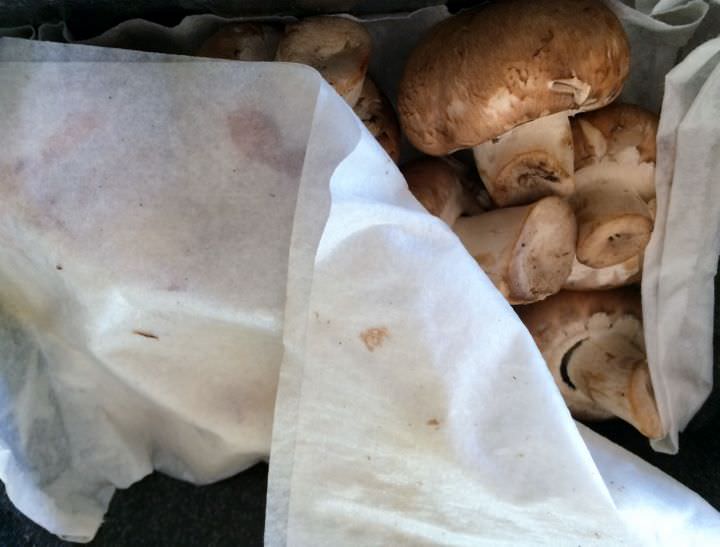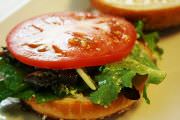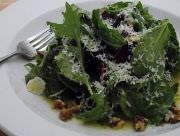Simple Steps For Food Safety And Storage
Food Safety And Storage
Food safety and storage are relatively straightforward concepts.
Keep cold foods below 40 degrees F. and hot foods above 140 degrees F. Between 40 and 140 degrees is the range referred to as the "danger zone". It is the range that most food borne contaminants thrive in.
Work clean, wash your hands, utensils, and work surfaces. Store food properly and avoid cross contamination.

How to properly store mushrooms: remove the plastic wrap when you get them home, line the bottom of the container with a paper towel, and place a damp paper towel over the top.
If the paper towel dries out in the fridge, sprinkle a little water over it and place back in the fridge. Mushrooms will keep this way for several days. The ones in the picture are 6 days old.
Proper food storage is a key component of food safety. Not only that but proper food storage practices will save you money.
Before you store your proteins, unwrap them and dry them with paper towels. Then wrap them individually in parchment paper. Finally wrap them with plastic wrap and store them in the coldest part of the refrigerator. Change the parchment and plastic wrap every other day.
Obviously, if you aren't planning on using them in a few days you should consider freezing them. The only exception would be fish. I never freeze fish, so, when I buy fish I use it within two days.
For produce I wrap it in paper towels and put them in the crisper drawers. For fresh herbs I line a plastic container with paper towels and arrange the herbs in layers between more paper towels and then seal the container with a lid and put them in the fridge. They keep very well for a couple weeks this way. Celery, however, likes moisture so keep it in plastic.
There's a theme here. Keep moisture off of your food and it keeps much longer and stays much fresher. This saves you money because you are not throwing out produce that has spoiled from improper storage.
Along the lines of money saving tips, a site that I really enjoy is the Save Money Guide, you should check it out. http://www.save-money-guide.com/
Food Borne Pathogens
Salmonella
Usually associated with poultry, but also attributed to vegetables that have been contaminated
E. Coli
Usually attributed to red meat that has been contaminated, typically during the slaughter practice.
Botulism
Typically associated with home canning, but the bacteria is anaerobic and will flourish in any oxygen free environment.
These are the big 3 food borne pathogens, however there are more. You can take a look at my page about food poisoning. It lists out the most common food borne pathogens with links to foodsafety.gov and NIH. My food poisoning page. You can also check out the Center for Disease Control, or CDC's, site for an exhaustive list of food borne pathogens and food safety, CDC.
Cross Contamination
One of the biggest issues with food safety and storage is avoiding cross contamination. Cross contamination is simply contaminating one surface or object and then allowing that surface or object to come in to contact with another surface or object. The pathogens that were on the contaminated surface or object transfer to the other.
The two biggest culprits behind cross contamination are not washing your hands or not washing your hands properly and not cleaning work surfaces and utensils. An example is cutting raw meat on a board and then cutting vegetable on top of the board without cleaning the board or knife. Seriously, don't do it!
When you are working in your kitchen, work clean. Wash your hands frequently, wipe down your boards, and wash your knives as needed to avoid cross contamination.
Cutting Boards And Food Safety
A study done at University of California Davis explains why wooden cutting boards are safer than plastic cutting boards.
The following is the gist of the study:
"We began our research comparing plastic and wooden cutting boards after the U.S. Department of Agriculture told us they had no scientific evidence to support their recommendation that plastic, rather than wooden cutting boards be used in home kitchens...Bacteria tested were E-coli, salmonella, listeria, campylobacter, and staphylococcus. We know of no similar research that has been done anywhere, so we regard it as the best epidemiological evidence available to date that wooden cutting boards are not a hazard to human health, but plastic cutting boards may be."
This is why I only use wooden cutting boards.
For the full text of the article go to:
http://faculty.vetmed.ucdavis.edu/faculty/docliver/Research/cuttingboard.htm
Note: this link will open a new window.
Food Allergies
The last argument in favor of food safety and storage is proper food handling to prevent cross contamination. Once you're aware of someone's allergy the easiest way to insure that they don't have an allergic reaction, aside from avoiding the trigger food, is preventing cross contamination.
Tags: food safety and storage




